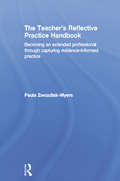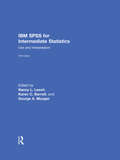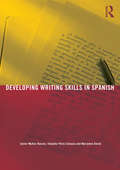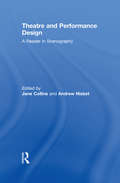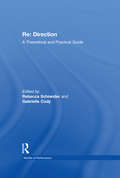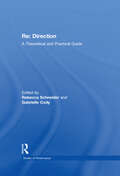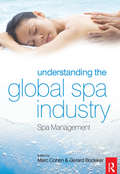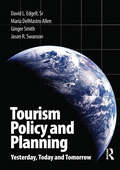- Table View
- List View
Debates in Music Teaching (Debates in Subject Teaching)
by Chris Philpott Gary SpruceDebates in Music Teaching encourages student and practising teachers to engage with contemporary issues and developments in music education. It aims to introduce a critical approach to the central concepts and practices that have influenced major interventions and initiatives in music teaching, and supports the development of new ways of looking at ideas around teaching and learning in music. Accessible and comprehensive chapters will stimulate thinking and creativity in relation to theory and practice, and will facilitate readers in reaching their own informed judgements and rationalising their position with deep theoretical knowledge and understanding. Throughout the book, international experts in the field consider key issues including: the justification for music in the school curriculum partnerships in music education and the identity of the music teacher technology and conceptions of musicianship social justice and music education the place of diverse musical genres and traditions in the music curriculum critical thinking and music education autonomy and integrity for music in cross-curricular work the politics, sociology and philosophy of music education. Debates in Music Teaching is for all student and practising teachers interested in furthering their understanding of the subject. Including carefully annotated further reading and reflective questions to help shape research and writing, this collection stimulates critical and creative thinking in relation to contemporary debates within music education.
Debates in Music Teaching (Debates in Subject Teaching)
by Chris Philpott Gary SpruceDebates in Music Teaching encourages student and practising teachers to engage with contemporary issues and developments in music education. It aims to introduce a critical approach to the central concepts and practices that have influenced major interventions and initiatives in music teaching, and supports the development of new ways of looking at ideas around teaching and learning in music. Accessible and comprehensive chapters will stimulate thinking and creativity in relation to theory and practice, and will facilitate readers in reaching their own informed judgements and rationalising their position with deep theoretical knowledge and understanding. Throughout the book, international experts in the field consider key issues including: the justification for music in the school curriculum partnerships in music education and the identity of the music teacher technology and conceptions of musicianship social justice and music education the place of diverse musical genres and traditions in the music curriculum critical thinking and music education autonomy and integrity for music in cross-curricular work the politics, sociology and philosophy of music education. Debates in Music Teaching is for all student and practising teachers interested in furthering their understanding of the subject. Including carefully annotated further reading and reflective questions to help shape research and writing, this collection stimulates critical and creative thinking in relation to contemporary debates within music education.
A Guided Reader for Secondary English: Pedagogy and practice
by David StevensThe Guided Reader for Secondary English draws on extracts from the published work of some of the most influential education writers to provide insight, guidance and clarity about key issues affecting Secondary English teachers. The book brings together key extracts from classic and contemporary writing and contextualises these in both theoretical and practical terms. The extracts are accompanied by a summary of the key ideas and issues raised, questions to promote discussion and reflective practice, and annotated further reading lists to extend thinking. Taking a thematic approach and including a short introduction to each theme, the chapters cover: Theoretical models of curricular English The nature and structure of the Secondary School English curriculum Historical perspectives Texts and intertextuality The arts context for secondary English Assessment and evaluation Linguistic and cultural contexts Future possibilities and tensions Aimed at trainee and newly qualified teachers including those working towards Masters level qualifications, as well as existing teachers, this accessible, but critically provocative text will be an essential resource for those that wish to deepen their understanding of Secondary English Education.
A Guided Reader for Secondary English: Pedagogy and practice
by David StevensThe Guided Reader for Secondary English draws on extracts from the published work of some of the most influential education writers to provide insight, guidance and clarity about key issues affecting Secondary English teachers. The book brings together key extracts from classic and contemporary writing and contextualises these in both theoretical and practical terms. The extracts are accompanied by a summary of the key ideas and issues raised, questions to promote discussion and reflective practice, and annotated further reading lists to extend thinking. Taking a thematic approach and including a short introduction to each theme, the chapters cover: Theoretical models of curricular English The nature and structure of the Secondary School English curriculum Historical perspectives Texts and intertextuality The arts context for secondary English Assessment and evaluation Linguistic and cultural contexts Future possibilities and tensions Aimed at trainee and newly qualified teachers including those working towards Masters level qualifications, as well as existing teachers, this accessible, but critically provocative text will be an essential resource for those that wish to deepen their understanding of Secondary English Education.
Airport Marketing
by Nigel Halpern Anne GrahamIn recent years, the airport sector has moved from an industry characterised by public sector ownership and national requirements, into a new era of airport management which is beginning to be dominated by the private sector and international players. Airports are now complex enterprises that require a wide range of business competencies and skills to meet the needs of their users, just as with any other industry. Moreover, deregulation of air transport markets has made the airport sector much more competitive and given airports greater incentives to develop innovative, proactive and aggressive marketing strategies so that they can reap the benefits from these developments. New types of airline business model, such as low cost carriers, have emerged through deregulation, which in many cases require a completely different approach to be adopted by airport marketers and have encouraged a further deviation from past practice. The travelling public is also becoming more experienced and is generally placing greater demands on the airport operator to deliver a quality product at a time when more stringent controls, especially as regards security, have been introduced. This accessible book fills an important need for an up-to-date, comprehensive and in-depth textbook that introduces students and practitioners to the principles and practice of airport marketing as well as the major changes and future marketing challenges facing the airport sector. It applies principles of marketing within the airport industry, and examines airport marketing and its environment, how to define and measure the market for airport services, airport marketing planning, and individual elements of the airport marketing mix (product, price, promotion and distribution). The book integrates key elements of marketing theory with airport marketing in practice. Each chapter contains extensive industry examples for different types of airports from around the world to build on the theoretical base of the subject and show real-life applications. The dynamic nature of the airport industry requires students and practitioners to have a thorough, up-to-date and contemporary appreciation of airport marketing issues and challenges. This comprehensive, accessible textbook written by two airport marketing experts satisfies this need and is essential reading for air transport students and future managers.
Airport Marketing
by Nigel Halpern Anne GrahamIn recent years, the airport sector has moved from an industry characterised by public sector ownership and national requirements, into a new era of airport management which is beginning to be dominated by the private sector and international players. Airports are now complex enterprises that require a wide range of business competencies and skills to meet the needs of their users, just as with any other industry. Moreover, deregulation of air transport markets has made the airport sector much more competitive and given airports greater incentives to develop innovative, proactive and aggressive marketing strategies so that they can reap the benefits from these developments. New types of airline business model, such as low cost carriers, have emerged through deregulation, which in many cases require a completely different approach to be adopted by airport marketers and have encouraged a further deviation from past practice. The travelling public is also becoming more experienced and is generally placing greater demands on the airport operator to deliver a quality product at a time when more stringent controls, especially as regards security, have been introduced. This accessible book fills an important need for an up-to-date, comprehensive and in-depth textbook that introduces students and practitioners to the principles and practice of airport marketing as well as the major changes and future marketing challenges facing the airport sector. It applies principles of marketing within the airport industry, and examines airport marketing and its environment, how to define and measure the market for airport services, airport marketing planning, and individual elements of the airport marketing mix (product, price, promotion and distribution). The book integrates key elements of marketing theory with airport marketing in practice. Each chapter contains extensive industry examples for different types of airports from around the world to build on the theoretical base of the subject and show real-life applications. The dynamic nature of the airport industry requires students and practitioners to have a thorough, up-to-date and contemporary appreciation of airport marketing issues and challenges. This comprehensive, accessible textbook written by two airport marketing experts satisfies this need and is essential reading for air transport students and future managers.
Teaching the Dimensions of Literacy: A Conceptual Base For The Teaching Of Reading And Writing In School Settings
by Stephen Kucer Cecilia SilvaTeaching the Dimensions of Literacy provides both the conceptual knowledge to support teachers' instructional decisions in the reading/literacy classroom and a multitude of instructional strategy lessons for classroom use with both monolingual and bilingual students. It proposes that teachers need to help children become code breakers (the linguistic dimension), meaning makers (the cognitive dimension), text users and critics (the sociocultural dimension), and scientists (the developmental dimension). Acknowledging and addressing all four dimensions, this text links literacy theory, literacy research, and literacy practice in a useable way. Covering both reading and writing, it features clear, concise, and useable reading and writing strategy lessons and ways to modify them for different types of students. Changes in the Second Edition: Entirely reorganized, the text is more user friendly, builds a stronger link between theory and practice, and makes it is easier for teachers to locate appropriate strategy lessons to use with their students. Academic literacy is addressed more fully.
Teaching the Dimensions of Literacy
by Stephen Kucer Cecilia SilvaTeaching the Dimensions of Literacy provides both the conceptual knowledge to support teachers' instructional decisions in the reading/literacy classroom and a multitude of instructional strategy lessons for classroom use with both monolingual and bilingual students. It proposes that teachers need to help children become code breakers (the linguistic dimension), meaning makers (the cognitive dimension), text users and critics (the sociocultural dimension), and scientists (the developmental dimension). Acknowledging and addressing all four dimensions, this text links literacy theory, literacy research, and literacy practice in a useable way. Covering both reading and writing, it features clear, concise, and useable reading and writing strategy lessons and ways to modify them for different types of students. Changes in the Second Edition: Entirely reorganized, the text is more user friendly, builds a stronger link between theory and practice, and makes it is easier for teachers to locate appropriate strategy lessons to use with their students. Academic literacy is addressed more fully.
The Teacher's Reflective Practice Handbook: Becoming an Extended Professional through Capturing Evidence-Informed Practice
by Paula Zwozdiak-MyersWhat do we mean by reflective practice? What does it involve? How can it help you develop as a teacher? The Teacher’s Reflective Practice Handbook is an essential source of advice, guidance and ideas for both student and practising teachers. Helping you to translate pedagogical knowledge into practice, this Handbook guides you through studying your own teaching for personal development, evaluating your lessons through classroom research, and enhancing the quality of pupil learning. It offers an innovative framework which serves to prepare you for the challenges and complexities of the classroom environment, and supports the continuing improvement of your teaching. Underpinned by key theoretical concepts and contemporary research within the field of education, chapters help you to: systematically evaluate your teaching through classroom research procedures question personal theories and beliefs, and consider alternative perspectives and possibilities try out new strategies and ideas to maximise the learning potential of all students enhance the quality of, and continue to improve, your teaching. Including a range of reflective tasks, links to online resources, exemplification material and further reading to help you develop your own thinking, The Teacher’s Reflective Practice Handbook is an accessible guide which supports the facilitation of reflective practice through self and peer assessment, problem-based learning and personal development planning. The multi-dimensional framework enables you to build a meaningful, personally relevant portfolio of evidence-informed practice.
Child Abuse and Neglect: Second Edition
by Monica L. McCoy Stefanie M. KeenChild abuse and neglect are examined in this new edition -- the latest research, what it entails, and how to recognize and report it. Federal law mandates the reporting of suspected child maltreatment by many professionals. This book will appeal to those who one day find themselves in the role of a mandated reporter. Engaging learning tools are integrated throughout: Focus on Research boxes provide an in-depth look at research or methodologies. Case Examples and Debates encourage discussion about the gray areas in the field. Legal Examples and Focus on Law sections explain judicial rulings including guides for locating relevant state statutes. Discussion questions promote dialogue and deepen understanding of the material. Bold faced key terms defined when first introduced also appear in the book's glossary. Conclusions and Definitions help students focus on the key concepts introduced in each chapter. The new edition also includes the following features: A thorough updating of the citations and state and federal laws, along with the latest statistics on incidence and prevalence based on the new National Incidence Study NIS-4. A new chapter on resiliency (Chapter 10) and more discussion of resilience in the face of maltreatment in the chapters on types of abuse (Chapters 4–9) provide a better understanding of why some children thrive despite experiencing maltreatment. New "Profiles" boxes that feature information about graduate training in child maltreatment, descriptions of jobs in the field, or biographies of people who work in the field to increase students‘ awareness of possible career opportunities. Web-based instructor resources including PowerPoints, weblinks, and a test bank with multiple-choice, short answer, and essay questions. More tables, figures, and photos to better illustrate and summarize key points. New sections on child maltreatment in military families (Chapter 2), child obesity as a result of maltreatment (Chapter 5), teen "sexting" and its possible prosecution as child sexual abuse and Susan Clancy’s controversial thesis published in The Trauma Myth (Chapter 7). Updated and more case examples including recent events that captured the public’s attention such as the case of Jessica Beagley convicted of child abuse for forcing her son to ingest hot sauce and of Latrece Jones convicted of negligent homicide for failing to have her son in a car seat. The book opens with the background on child maltreatment including its history, an overview of the research, and the risk factors. Details about mandated reporting are also explored. Different forms of maltreatment – physical abuse, neglect, psychological maltreatment, sexual abuse, fetal abuse, and Munchausen by Proxy Syndrome – are then examined, along with the new chapter on resiliency. Incidence estimates and consequences for each type of maltreatment are provided. Legal issues including forensic interviewing are then reviewed. The book concludes with an example of what happens to a child after a report is filed along with suggestions for preventing child maltreatment. Intended as a text for courses in child abuse, child maltreatment, family violence, or sexual and intimate violence taught in psychology, human development, education, criminal justice, social work, sociology, women’s studies, and nursing, this book is also an invaluable resource to workers who are mandated reporters of child maltreatment and/or anyone interested in the problem.
Child Abuse and Neglect: Second Edition
by Monica L. McCoy Stefanie M. KeenChild abuse and neglect are examined in this new edition -- the latest research, what it entails, and how to recognize and report it. Federal law mandates the reporting of suspected child maltreatment by many professionals. This book will appeal to those who one day find themselves in the role of a mandated reporter. Engaging learning tools are integrated throughout: Focus on Research boxes provide an in-depth look at research or methodologies. Case Examples and Debates encourage discussion about the gray areas in the field. Legal Examples and Focus on Law sections explain judicial rulings including guides for locating relevant state statutes. Discussion questions promote dialogue and deepen understanding of the material. Bold faced key terms defined when first introduced also appear in the book's glossary. Conclusions and Definitions help students focus on the key concepts introduced in each chapter. The new edition also includes the following features: A thorough updating of the citations and state and federal laws, along with the latest statistics on incidence and prevalence based on the new National Incidence Study NIS-4. A new chapter on resiliency (Chapter 10) and more discussion of resilience in the face of maltreatment in the chapters on types of abuse (Chapters 4–9) provide a better understanding of why some children thrive despite experiencing maltreatment. New "Profiles" boxes that feature information about graduate training in child maltreatment, descriptions of jobs in the field, or biographies of people who work in the field to increase students‘ awareness of possible career opportunities. Web-based instructor resources including PowerPoints, weblinks, and a test bank with multiple-choice, short answer, and essay questions. More tables, figures, and photos to better illustrate and summarize key points. New sections on child maltreatment in military families (Chapter 2), child obesity as a result of maltreatment (Chapter 5), teen "sexting" and its possible prosecution as child sexual abuse and Susan Clancy’s controversial thesis published in The Trauma Myth (Chapter 7). Updated and more case examples including recent events that captured the public’s attention such as the case of Jessica Beagley convicted of child abuse for forcing her son to ingest hot sauce and of Latrece Jones convicted of negligent homicide for failing to have her son in a car seat. The book opens with the background on child maltreatment including its history, an overview of the research, and the risk factors. Details about mandated reporting are also explored. Different forms of maltreatment – physical abuse, neglect, psychological maltreatment, sexual abuse, fetal abuse, and Munchausen by Proxy Syndrome – are then examined, along with the new chapter on resiliency. Incidence estimates and consequences for each type of maltreatment are provided. Legal issues including forensic interviewing are then reviewed. The book concludes with an example of what happens to a child after a report is filed along with suggestions for preventing child maltreatment. Intended as a text for courses in child abuse, child maltreatment, family violence, or sexual and intimate violence taught in psychology, human development, education, criminal justice, social work, sociology, women’s studies, and nursing, this book is also an invaluable resource to workers who are mandated reporters of child maltreatment and/or anyone interested in the problem.
IBM SPSS for Intermediate Statistics: Use and Interpretation, Fifth Edition
by Nancy L. Leech Karen C. Barrett George A. MorganDesigned to help readers analyze and interpret research data using IBM SPSS, this user-friendly book shows readers how to choose the appropriate statistic based on the design; perform intermediate statistics, including multivariate statistics; interpret output; and write about the results. The book reviews research designs and how to assess the accuracy and reliability of data; how to determine whether data meet the assumptions of statistical tests; how to calculate and interpret effect sizes for intermediate statistics, including odds ratios for logistic analysis; how to compute and interpret post-hoc power; and an overview of basic statistics for those who need a review. Unique chapters on multilevel linear modeling; multivariate analysis of variance (MANOVA); assessing reliability of data; multiple imputation; mediation, moderation, and canonical correlation; and factor analysis are provided. SPSS syntax with output is included for those who prefer this format. The new edition features: • IBM SPSS version 22; although the book can be used with most older and newer versions • New discusiion of intraclass correlations (Ch. 3) • Expanded discussion of effect sizes that includes confidence intervals of effect sizes (ch.5) • New information on part and partial correlations and how they are interpreted and a new discussion on backward elimination, another useful multiple regression method (Ch. 6) • New chapter on how to use a variable as a mediator or a moderator (ch. 7) • Revised chapter on multilevel and hierarchical linear modeling (ch. 12) • A new chapter (ch. 13) on multiple imputation that demonstrates how to deal with missing data • Updated web resources for instructors including PowerPoint slides and answers to interpretation questions and extra problems and for students, data sets, chapter outlines, and study guides. IBM SPSS for Intermediate Statistics, Fifth Edition provides helpful teaching tools: • all of the key SPSS windows needed to perform the analyses • outputs with call-out boxes to highlight key points • interpretation sections and questions to help students better understand and interpret the output • extra problems with realistic data sets for practice using intermediate statistics • Appendices on how to get started with SPSS, write research questions, and basic statistics. An ideal supplement for courses in either intermediate/advanced statistics or research methods taught in departments of psychology, education, and other social, behavioral, and health sciences. This book is also appreciated by researchers in these areas looking for a handy reference for SPSS
IBM SPSS for Intermediate Statistics: Use and Interpretation, Fifth Edition
by Nancy L. Leech Karen C. Barrett George A. MorganDesigned to help readers analyze and interpret research data using IBM SPSS, this user-friendly book shows readers how to choose the appropriate statistic based on the design; perform intermediate statistics, including multivariate statistics; interpret output; and write about the results. The book reviews research designs and how to assess the accuracy and reliability of data; how to determine whether data meet the assumptions of statistical tests; how to calculate and interpret effect sizes for intermediate statistics, including odds ratios for logistic analysis; how to compute and interpret post-hoc power; and an overview of basic statistics for those who need a review. Unique chapters on multilevel linear modeling; multivariate analysis of variance (MANOVA); assessing reliability of data; multiple imputation; mediation, moderation, and canonical correlation; and factor analysis are provided. SPSS syntax with output is included for those who prefer this format. The new edition features: • IBM SPSS version 22; although the book can be used with most older and newer versions • New discusiion of intraclass correlations (Ch. 3) • Expanded discussion of effect sizes that includes confidence intervals of effect sizes (ch.5) • New information on part and partial correlations and how they are interpreted and a new discussion on backward elimination, another useful multiple regression method (Ch. 6) • New chapter on how to use a variable as a mediator or a moderator (ch. 7) • Revised chapter on multilevel and hierarchical linear modeling (ch. 12) • A new chapter (ch. 13) on multiple imputation that demonstrates how to deal with missing data • Updated web resources for instructors including PowerPoint slides and answers to interpretation questions and extra problems and for students, data sets, chapter outlines, and study guides. IBM SPSS for Intermediate Statistics, Fifth Edition provides helpful teaching tools: • all of the key SPSS windows needed to perform the analyses • outputs with call-out boxes to highlight key points • interpretation sections and questions to help students better understand and interpret the output • extra problems with realistic data sets for practice using intermediate statistics • Appendices on how to get started with SPSS, write research questions, and basic statistics. An ideal supplement for courses in either intermediate/advanced statistics or research methods taught in departments of psychology, education, and other social, behavioral, and health sciences. This book is also appreciated by researchers in these areas looking for a handy reference for SPSS
Empowering the Children’s and Young People’s Workforce: Practice based knowledge, skills and understanding
by Simon BrownhillWhile the provision in Children’s and Young People’s Services endures much change and turbulence, the calling for well qualified and critically reflective practitioners remains ever present. This innovative and accessible core textbook explores the key themes, ideas, concepts and topics that are central to practitioners working across the 0-19 sector. It aims to help students develop the professional knowledge, practical skills and core values they need to work effectively with children and young people. Clearly divided into four sections; the practitioner, the learner, the workplace and the community, the book covers a broad range of issues including: The different roles and responsibilities of the workforce Multi-agency working and its challenges Working with parents, carers and the community Supporting children with additional needs and meeting the needs of gifted learners Work-based reflective practice Language learning and communication At each stage the book facilitates opportunities for personal and professional reflection, discussion, debate and action through case studies, activities, reflective tasks, areas for further consideration, and annotated further readings. The text also features a glossary of terms and links to practice standards. The book is supported by a free companion website featuring instructor resources such as assignable case studies, reflective tasks and activities, tables and figures from the book available to download, and sample chapters from the book; and student resources including helpful links to further information, links to relevant video material, and an interactive flashcard glossary. Empowering the Children’s and Young People’s Workforce seeks to empower the reader by supporting their initial and continuing professional development, enabling them to positively influence provision for children and young people. It is essential reading for anyone studying or working in this sector.
Empowering the Children’s and Young People’s Workforce: Practice based knowledge, skills and understanding
by Simon BrownhillWhile the provision in Children’s and Young People’s Services endures much change and turbulence, the calling for well qualified and critically reflective practitioners remains ever present. This innovative and accessible core textbook explores the key themes, ideas, concepts and topics that are central to practitioners working across the 0-19 sector. It aims to help students develop the professional knowledge, practical skills and core values they need to work effectively with children and young people. Clearly divided into four sections; the practitioner, the learner, the workplace and the community, the book covers a broad range of issues including: The different roles and responsibilities of the workforce Multi-agency working and its challenges Working with parents, carers and the community Supporting children with additional needs and meeting the needs of gifted learners Work-based reflective practice Language learning and communication At each stage the book facilitates opportunities for personal and professional reflection, discussion, debate and action through case studies, activities, reflective tasks, areas for further consideration, and annotated further readings. The text also features a glossary of terms and links to practice standards. The book is supported by a free companion website featuring instructor resources such as assignable case studies, reflective tasks and activities, tables and figures from the book available to download, and sample chapters from the book; and student resources including helpful links to further information, links to relevant video material, and an interactive flashcard glossary. Empowering the Children’s and Young People’s Workforce seeks to empower the reader by supporting their initial and continuing professional development, enabling them to positively influence provision for children and young people. It is essential reading for anyone studying or working in this sector.
Developing Writing Skills in Spanish (Developing Writing Skills Ser.)
by Javier Muñoz-Basols Yolanda Pérez Sinusía Marianne DavidDeveloping Writing Skills in Spanish provides intermediate and advanced level students with the necessary skills to become competent and confident writers in the Spanish language. With a focus on writing as a craft, Developing Writing Skills in Spanish offers a rich selection of original materials including narrative texts, expository essays, opinion pieces and newspaper articles. Each chapter covers a specific kind of writing and is designed to help tackle the material in small units. The book aids students in crafting clear, coherent and cohesive manuscripts by means of guided practice and step-by-step activities. Key features: Guidance on how to structure a variety of texts: narrative, descriptive, expository, argumentative, academic, journalistic, legal and scientific. Sequenced exercises on style, writing conventions, word choice, syntax and grammar. Reference lists and tables with specialized vocabulary, transition words and other useful expressions. Strategies and tips for planning manuscripts, brainstorming ideas, vocabulary enrichment, editing and proofreading. Includes original samples, as well as fragments from newspapers, well-known literary works and essays by notable Hispanic authors and journalists. Website with additional activities to reinforce the content of each chapter and a teacher's guide with valuable support materials at: www.developingwritingskills.com Designed as a classroom text, self-study material or simply as a resource on writing, Developing Writing Skills in Spanish is the ideal supplement for all intermediate to advanced students of Spanish.
Developing Writing Skills in Spanish
by Javier Muñoz-Basols Yolanda Pérez Sinusía Marianne DavidDeveloping Writing Skills in Spanish provides intermediate and advanced level students with the necessary skills to become competent and confident writers in the Spanish language. With a focus on writing as a craft, Developing Writing Skills in Spanish offers a rich selection of original materials including narrative texts, expository essays, opinion pieces and newspaper articles. Each chapter covers a specific kind of writing and is designed to help tackle the material in small units. The book aids students in crafting clear, coherent and cohesive manuscripts by means of guided practice and step-by-step activities. Key features: Guidance on how to structure a variety of texts: narrative, descriptive, expository, argumentative, academic, journalistic, legal and scientific. Sequenced exercises on style, writing conventions, word choice, syntax and grammar. Reference lists and tables with specialized vocabulary, transition words and other useful expressions. Strategies and tips for planning manuscripts, brainstorming ideas, vocabulary enrichment, editing and proofreading. Includes original samples, as well as fragments from newspapers, well-known literary works and essays by notable Hispanic authors and journalists. Website with additional activities to reinforce the content of each chapter and a teacher's guide with valuable support materials at: www.developingwritingskills.com Designed as a classroom text, self-study material or simply as a resource on writing, Developing Writing Skills in Spanish is the ideal supplement for all intermediate to advanced students of Spanish.
Theatre and Performance Design: A Reader in Scenography
by Jane Collins Andrew NisbetTheatre and Performance Design: A Reader in Scenography is an essential resource for those interested in the visual composition of performance and related scenographic practices. Theatre and performance studies, cultural theory, fine art, philosophy and the social sciences are brought together in one volume to examine the principle forces that inform understanding of theatre and performance design. The volume is organised thematically in five sections: looking, the experience of seeing space and place the designer: the scenographic bodies in space making meaning This major collection of key writings provides a much needed critical and contextual framework for the analysis of theatre and performance design. By locating this study within the broader field of scenography – the term increasingly used to describe a more integrated reading of performance – this unique anthology recognises the role played by all the elements of production in the creation of meaning. Contributors include Josef Svoboda, Richard Foreman, Roland Barthes, Oscar Schlemmer, Maurice Merleau-Ponty, Richard Schechner, Jonathan Crary, Elizabeth Wilson, Henri Lefebvre, Adolph Appia and Herbert Blau.
Theatre and Performance Design: A Reader in Scenography
by Jane Collins Andrew NisbetTheatre and Performance Design: A Reader in Scenography is an essential resource for those interested in the visual composition of performance and related scenographic practices. Theatre and performance studies, cultural theory, fine art, philosophy and the social sciences are brought together in one volume to examine the principle forces that inform understanding of theatre and performance design. The volume is organised thematically in five sections: looking, the experience of seeing space and place the designer: the scenographic bodies in space making meaning This major collection of key writings provides a much needed critical and contextual framework for the analysis of theatre and performance design. By locating this study within the broader field of scenography – the term increasingly used to describe a more integrated reading of performance – this unique anthology recognises the role played by all the elements of production in the creation of meaning. Contributors include Josef Svoboda, Richard Foreman, Roland Barthes, Oscar Schlemmer, Maurice Merleau-Ponty, Richard Schechner, Jonathan Crary, Elizabeth Wilson, Henri Lefebvre, Adolph Appia and Herbert Blau.
Destination Brands
by Nigel Morgan Annette Pritchard Roger PrideThis textbook shows how cities, regions and countries adopt branding strategies similar to those of leading household brand names in an effort to differentiate themselves and emotionally connect with potential tourists. It asks whether tourist destinations get the reputations they deserve and uses topical case studies to discuss brand concepts and challenges. It tackles how place perceptions are formed, how cities, regions and countries can enhance their reputations as creative, competitive destinations, and the link between competitive identity and strategic tourism policy making.
Destination Brands
by Nigel Morgan Annette Pritchard Roger PrideThis textbook shows how cities, regions and countries adopt branding strategies similar to those of leading household brand names in an effort to differentiate themselves and emotionally connect with potential tourists. It asks whether tourist destinations get the reputations they deserve and uses topical case studies to discuss brand concepts and challenges. It tackles how place perceptions are formed, how cities, regions and countries can enhance their reputations as creative, competitive destinations, and the link between competitive identity and strategic tourism policy making.
Re: A Theoretical and Practical Guide (Worlds of Performance)
by Gabrielle Cody Rebecca SchneiderRe: Direction is an extraordinary resource for practitioners and students on directing. It provides a collection of ground-breaking interviews, primary sources and essays on 20th century directing theories and practices around the world. Helpfully organized into four key areas of the subject, the book explores: * theories of directing * the boundaries of the director's role * the limits of categorization * the history of the theatre and performance art. Exceptionally useful and thought-provoking introductory essays by editors Schneider and Cody guide you through the wealth of materials included here. Re: Direction is the kind of book anyone interested in theatre history should own, and which will prove an indispensable toolkit for a lifetime of study.
Re: A Theoretical and Practical Guide (Worlds of Performance)
by Gabrielle Cody Rebecca SchneiderRe: Direction is an extraordinary resource for practitioners and students on directing. It provides a collection of ground-breaking interviews, primary sources and essays on 20th century directing theories and practices around the world. Helpfully organized into four key areas of the subject, the book explores: * theories of directing * the boundaries of the director's role * the limits of categorization * the history of the theatre and performance art. Exceptionally useful and thought-provoking introductory essays by editors Schneider and Cody guide you through the wealth of materials included here. Re: Direction is the kind of book anyone interested in theatre history should own, and which will prove an indispensable toolkit for a lifetime of study.
Understanding the Global Spa Industry
by Marc Cohen Gerry BodekerThe spa industry is currently the fastest growing segment of the hospitality and leisure industry with revenues exceeding those from amusement parks, box office receipts, vacation ownership gross sales and ski resort ticket sales.Understanding the Global Spa Industry is the first book to examine management practices in this industry and offers a groundbreaking and comprehensive approach to global spa management, covering everything from the beginnings of the industry through to contemporary management and social and ethical issues.With contributions from internationally renowned business leaders, practitioners and academics, this unique book is packed with case studies, examples and advice for all those working in, and studying, the international spa industry.Understanding the Global Spa Industry brings an analytic lens to the spa movement, examining past, current and future trends and the potential for shaping wellness and health services in the 21st century.
Tourism Policy and Planning: Yesterday, Today, And Tomorrow
by David L. Edgell Sr Maria DelMastro Allen Ginger Smith Jason R. SwansonFor many communities and countries throughout the world tourism is the most valuable industry. Economic changes taking place in China, India, and the United States (with almost 3 billion people, half the world's population), for example, will have major impacts on the global tourism markets of tomorrow. Social-cultural changes in Europe, with borderless tourism crossings and a common currency, are increasing opportunities for tourism growth. East Asia and the Pacific Rim are experiencing unprecedented growth and change in tourism. From the perspective of economic policy, tourism for local communities is a vital economic development tool producing income, creating jobs, spawning new businesses, spurring economic development, promoting economic diversification, developing new products, and contributing to economic integration. If local and national governments are committed to broad based tourism policies, then tourism will provide its citizens with a higher quality of life while it generates sustained economic, environmental, and social benefits. The wellspring to future growth for tourism throughout the world is a commitment toward good policy. Governments, the private sector, and not-for-profit agencies must be the leaders in a sustainable tourism policy that transcends the economic benefits and embraces environmental and cultural interests as well. Tourism Policy and Planning: Yesterday, Today, and Tomorrow addresses key ingredients for positive tourism policies and planning that will lead this generation and the next toward a greater quality of life resulting from tourism growth. The aim of this book is to provide government policy-makers (at all levels), business leaders, not-for-profit executives, university professors, students, tourism industry managers, and the general public with an introduction and examination of important policy and planning issues in tourism.




